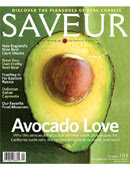Like Butter, the mystic of avocados, which lend depth and creaminess to coutless dishes, is timeless
 Excerpts from an article in Saveur Magazine, August/September 2007
Excerpts from an article in Saveur Magazine, August/September 2007
by Andrea Nguyen
Americans have developed a prodigious appetite for avocados in recent years; since 1990 the consumption of avocados in this country has more than doubled, thanks in part to an influx of immigrants from Latin American and also to the ever diversifying tastes of Americans of all backgrounds. Today, we eat more than we produce, importing the fruit in greater quantities (almost 300,000 tons in 2005) than any other country.
Today avocado orchards thrive in many countries, but the bulk of the world's commercially grown produce comes from Mexico, Indonesia, the US and Colombia.
The most familiar to American consumers is the bulb-shaped , dark-skinned hass. Some of the lesser known, like the donnie are large, smooth, and shaped like eggs; others like the macarthur, look more like bartlett pears.
Well into the 20th century, many Americans referred to the fruit as alligator pears, likely owing to the scale like marks that appear on some avocados skins when the fruit rubs against a branch or the trunk of its tree. This scale appearance doesn't bruise the fruit, the creamy buttery flesh will bear no mark.

Though farmers had started growing avocados in Hawaii, Florida and California by the mid-1800s, few American home cooks had heard of the fruit. Those who had heard of it thought it on par with the banana or pineapple, both rarities at the time. Not surprising given one fruit costs 40 cents or roughly $9 in today's money.
 Soon avocados began to appear in recipe books of the era, often thanks to the promotional efforts of growers. The recipes didn't tap into authentic foreign cuisines. Food writers instead deftly mixed avocados with sugar and sherry or deep-fried them.
Soon avocados began to appear in recipe books of the era, often thanks to the promotional efforts of growers. The recipes didn't tap into authentic foreign cuisines. Food writers instead deftly mixed avocados with sugar and sherry or deep-fried them.It was a single Mexican side dish, however, than definitively sparked mainstream America's passion for the fruit. Guacamole become a tabletop staple in themed restaurants and bars and a party staple in the 1970s.
The cover of a 1970 issue of Sunset magazine summed up its popularity: "Versatile, it's a dip, a sauce, a dressing, a spread." Today Americans have made guacamole their own. On Super bowl Sunday alone, nearly 55 million pounds of avocados are sold across the 50 states.
The Pantry - a guide to resources Saveur discovered while producing this issue.
Avocados...To find donnie and other varieties of avocado grown in Florida or for more details on the seasonality of Florida's avocado varieties, visit www.brookstropicals.com/saveur.

